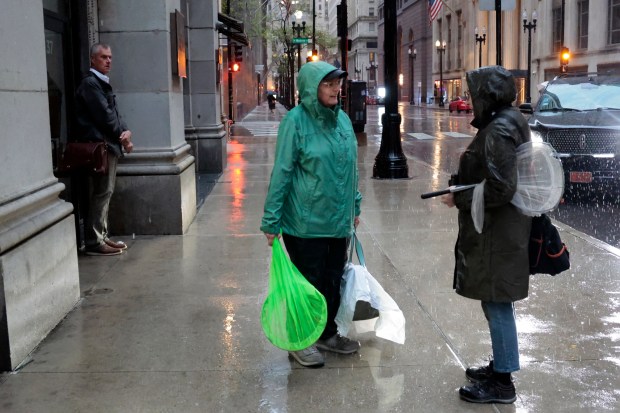A total of 10,836 birds are known to have died last year after crashing into the windows of Chicago-area buildings, and artist Holly Greenberg intends to display a life-sized replica of each and every one.
Greenberg is launching the project this summer with free crafting workshops where anyone can make a bird using upcycled fabric and donated materials.
She hopes the massive, crowdsourced project — culminating in a “red carpet” of handmade birds as long as a football field — will educate the public about at-home solutions and highlight the long battle for mandatory bird-safety measures at new Chicago high-rises.
“The more people that know about this, the more people can pressure Mayor (Brandon) Johnson to revisit that (issue),” Greenberg said. “More voices need to be added so there is real legislative change.”
Johnson’s office did not respond to a request for comment.
Greenberg’s project comes less than a year after Chicago’s bird-fatality problem made national news. In October, at least 960 migrating birds died in a single day, after crashing into a single lakefront building.
Chicago is one of the nation’s most dangerous cities for migrating birds, due to factors such as its size, proximity to Lake Michigan, many tall, glass buildings, and its location in a major migration route, the Mississippi Flyway.
But while some cities — including Evanston and New York — have enacted mandatory bird-safe building standards, Chicago has not.
Bags of dead birds
Greenberg, an associate professor at Syracuse University, stumbled upon the issue when she was on sabbatical in Evanston in 2022 and 2023.
Evanston wasn’t her first choice of location, she said with a laugh — she actually wanted to go to Italy. But when visa issues proved too great a hurdle, she turned to the Chicago area, where she got her MFA at the Art Institute and taught at Columbia College.
During her time in Evanston, Greenberg, an artist who focuses on environmental issues and sustainability, met people who were volunteering for Chicago Bird Collision Monitors.
The monitors walk high-risk areas in the early morning during migration season, looking for crash victims. Surviving birds are transferred to the the Willowbrook Wildlife Center in Glen Ellyn for care and possible release back into the wild, and the dead are transported to the Field Museum for record-keeping, preservation and study.
One day when Greenberg was at the home of an Evanston friend and bird collision monitor, another monitor dropped off two grocery bags full of dead birds from the Northwestern campus. The birds were frozen for transport to the Field Museum.
“It was masses of these beautiful birds and their gorgeous feathers, and they (were) dead,” Goldberg said. “I thought, ‘Not enough people know about this. This is happening right here.’”
Soon she was thinking about an art project: She wanted to get preserved bird carcasses from the Field Museum and line them up to create a pathway snaking through the Northwestern campus. She envisioned a path leading right up to the university president’s door, installed in time for Parents Weekend.
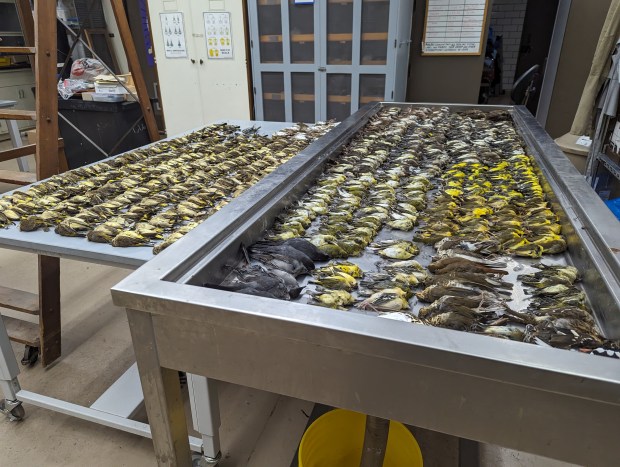
Her friends the bird advocates were not enthusiastic. The project was too aggressive, they told her. That’s not the way Chicago-area bird advocates frame their messages.
Greenberg went home to Syracuse without a definite plan, but then on Oct.6, she read that at least 960 birds had died crashing into a single Chicago building on a single day. The building, McCormick Place Lakeside Center, is currently applying bird-safety film to its windows at a cost of $1.2 million.
“I cannot sit on this project anymore,” Greenberg said to herself when she read about the 960 birds. “I have to do something.”
She decided she would use fabric birds, displayed side by side in long rows, as if they were specimens laid out on a tray at the Field Museum.
Greenberg spoke to the Field Museum’s bird division collections manager emeritus David Willard, who gave her the complete list of all the dead birds that came to the museum in 2023 after Chicago-area window collisions. Most of the birds died in or around the Loop, where volunteers canvas for birds during migration season, or at McCormick Place Lakeside, which is monitored by the Field Museum.
Greenberg is using the Field Museum list to replicate each and every one of the birds — creating a cedar waxwing, for example, for every cedar waxwing that died.
Offering solutions
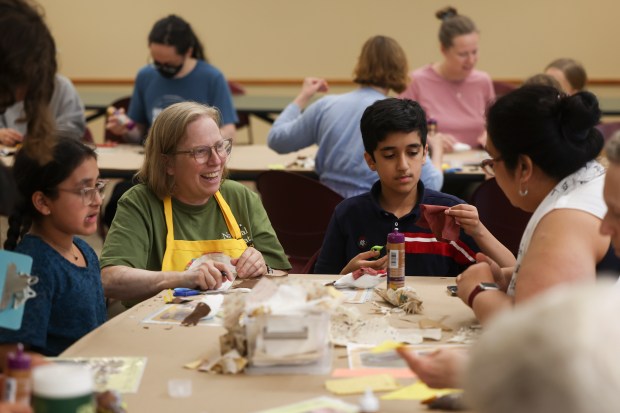
At a recent bird-crafting event at the Evanston Public Library, Greenberg was joined by four assistants, including her sons Gulliver Brower, 20, an electrical engineering major at Syracuse, and Eisen Brower, 17, a high school senior. Wearing homemade canary-yellow aprons that Gulliver and Eisen had sewn, the team greeted a capacity crowd of 31 that arrived promptly at 4 p.m.
With no more seats available, additional guests were asked to come back; the event would last until 7 and some bird-makers take only 20 minutes to complete their work.
There was even a returning bird-maker.
Heather O’Leary had attended a previous event held at an Evanston street fair. O’Leary and her daughter Leah, 6, celebrated Leah’s birthday at that first bird-making session.
Now they were returning to celebrate another birthday: O’Leary’s.
“We’ve been telling everybody (about this) and we also heard some random buzz from people on the street,” said O’Leary, an anthropology professor who grew up in Evanston.
The room filled with conversation as participants, many of them school-age children, parents and senior citizens, chose the species they would replicate. Among the options displayed on big, colorful cards the size of placemats: lemony cedar waxwings, common yellowthroats with bandit eye-mask markings, and black-throated blue warblers in shades of midnight and indigo.

Some bird-makers moved quickly and decisively; others puzzled over the problem of covering a three-dimensional stuffed bird with flat fabric, using only scissors and glue.
Some said they came for the art; others were drawn by the birds.
“We just wanted to help the cause and save the birds and make awareness of birds hitting the windows,” said Ezra Pollet, 11, of Evanston.
Greenberg went from table to table, asking questions, praising artwork and offering information about bird-friendly windows.
“Have you had a bird hit your window?” she asked a woman in a blue shirt.
“Oh yeah, all the time.” Fortunately, the woman added, she’d never found a dead bird.
A little boy sitting across the table piped up, enunciating each word slowly and carefully: “I probably know why you didn’t see them. They might get eaten.”
Greenberg offered ideas for making home windows safer, including applying small dots to the outside using tape which she could provide for free, thanks to a donation from the Ontario company Feather Friendly.
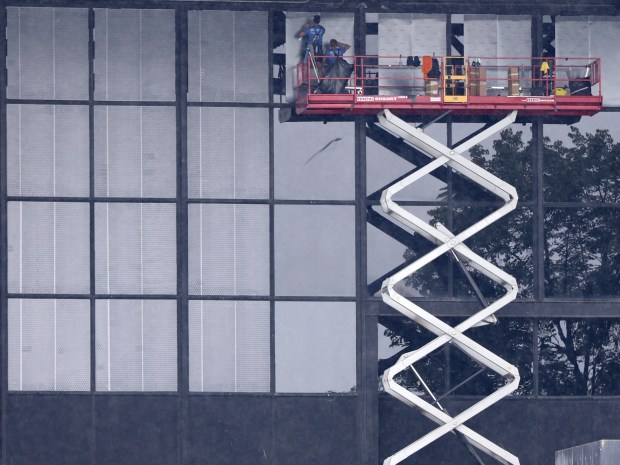
At a display in the front of the room, Bird-Friendly Evanston co-leader Leslie Shad, who was assisting Greenberg, showed other options, including DIY cord curtains you can hang over your windows, using the directions at Acopian BirdSavers.
This kind of homeowner bird-collision education is important, according to Judy Pollock, president of the Chicago Bird Alliance, which is supporting Greenberg’s project.
Buildings one to three stories are responsible for about 44% of fatal bird-building collisions, according to a frequently cited 2014 study.
“Homeowners are a big part of the solution and (Greenberg) is out there, showing homeowners how they can resolve their window problems in a really engaging way,” Pollock said.
A five-year plan
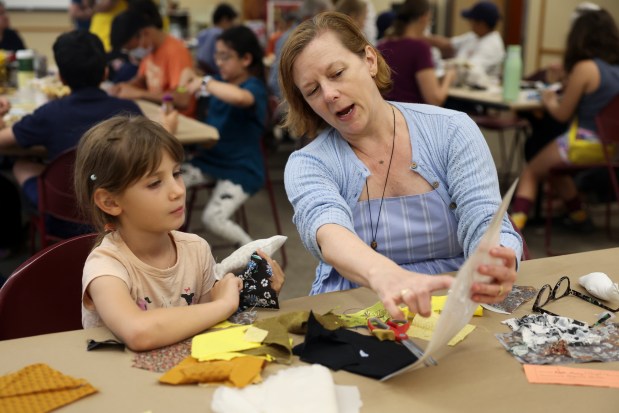
Pollock and other bird advocates suffered a setback earlier this year, when Chicago declined to make bird-safe building practices mandatory for some new buildings.
Now advocates are seeking an ordinance, Pollock said. She believes such a measure would have strong public support.
“People don’t want to live in a city that kills birds,” she said.
Shad noted that Evanston and New York already have laws mandating bird-safety measures.
“Developers and architects are coming around and realizing that this may be the ‘seat belt’ of the building: They don’t particularly like it, but it’s just something they have to deal with going forward,” Shad said. “It just feels like there’s room for that if the policymakers step up.”
Greenberg, who has over 300 completed birds, is tagging each one like a specimen in the Field Museum with its common name, scientific name and place and date of death. She’s also including the name of the person who made the bird.
She hopes to display the final artwork downtown, near the big buildings where most of the birds died — maybe at the Chicago Cultural Center, she said, or Millennium Park.
“The buildings there that are maybe less cooperative about making adjustments to their windows would be shamed,” she said. “They’d be like, ‘Oh, wow. That’s how many birds died last year.’”
Exactly when the big reveal will take place is unclear. Greenberg acknowledged that her goal is ambitious, and that her five-year timeline for completion is just an estimate.
Still, her mood was decidedly upbeat as, surrounded by bright scraps of fabric and freshly made wings and beaks, she contemplated the road ahead.
“I’m not really worried, because the longer it takes, the more people I get to talk to about bird collisions,” she said.
nschoenberg@chicagotribune.com


